The AMD Trinity Review (A10-4600M): A New Hope
by Jarred Walton on May 15, 2012 12:00 AM ESTAMD Trinity General Performance
Starting as usual with our general performance assessment, we’ve got several Futuremark benchmarks along with Cinebench and x264 HD encoding. The latter two focus specifically on stressing the CPU while PCMarks will cover most areas of system performance (including a large emphasis on storage) and 3DMarks will give us a hint at graphics performance. First up, PCMark 7 and Vantage:
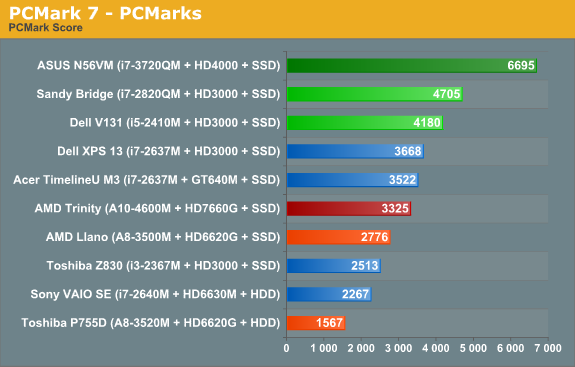
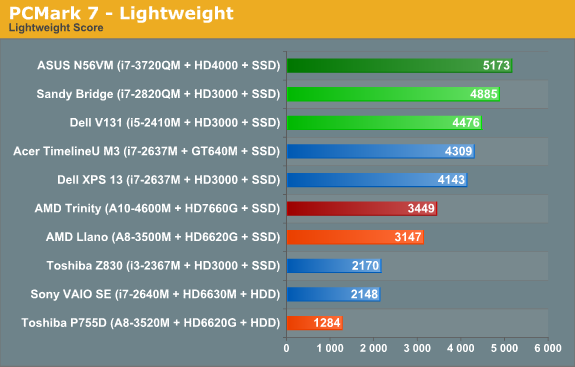
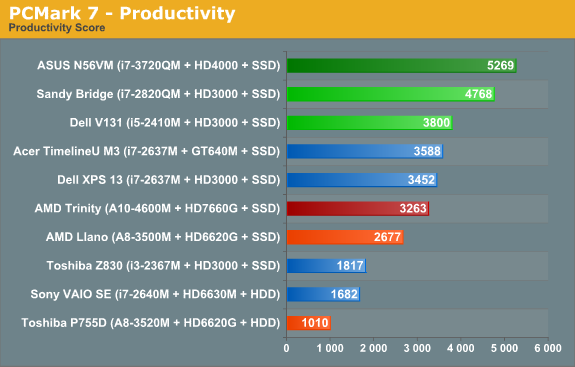

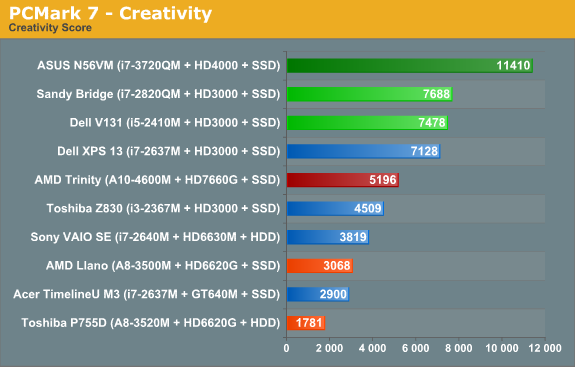
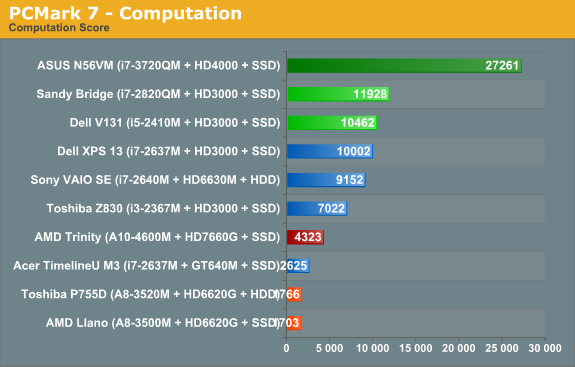
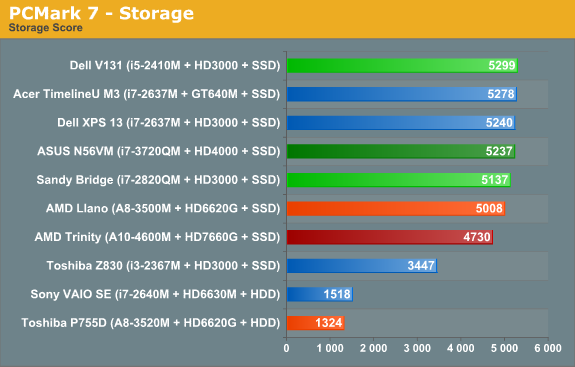
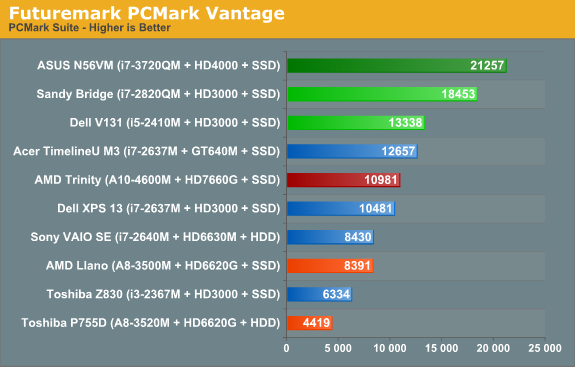
As noted earlier, we ran several other laptops through PCMark 7 and PCMark Vantage testing using the same Intel 520 240GB SSD, plus all the ultrabooks come with SSDs. That removes the SSD as a factor from most of the PCMark comparisons, leaving the rest of the platform to sink or swim on its own. And just how does AMD Trinity do here? Honestly, it’s not too bad, despite positioning within the charts.
Obviously, Intel’s quad-core Ivy Bridge is a beast when it comes to performance, but it’s a 45W beast that costs over $300 just for the CPU. We’ll have to wait for dual-core Ivy Bridge to see exactly how Intel’s latest stacks up against AMD, but if you remember the Llano vs. Sandy Bridge comparisons it looks like we’re in for more of the same. Intel continues to offer superior CPU performance, and even their Sandy Bridge ULV processors can often surpass Llano and Trinity. In the overall PCMark 7 metric, Trinity ends up being 20% faster than a Llano A8-3500M laptop, while Intel’s midrange i5-2410M posts a similar 25% lead on Trinity. Outside of the SSD, we’d expect Trinity and the Vostro V131 to both sell for around $600 as equipped.
A 25% lead for Intel is pretty big, but what you don’t necessarily get from the charts is that for many users, it just doesn’t matter. I know plenty of people using older Core 2 Duo (and even a few Core Duo!) laptops, and for general office tasks and Internet surfing they’re fine. Llano was already faster in general use than Core 2 Duo and Athlon X2 class hardware, and it delivered great battery life. Trinity boosts performance and [spoiler alert!] battery life, so it’s a net win. If you’re looking for a mobile workstation or something to do some hardcore gaming, Trinity won’t cut it—you’d want a quad-core Intel CPU for the former, and something with a discrete GPU for the latter—but for everything else, we’re in the very broad category known as “good enough”.


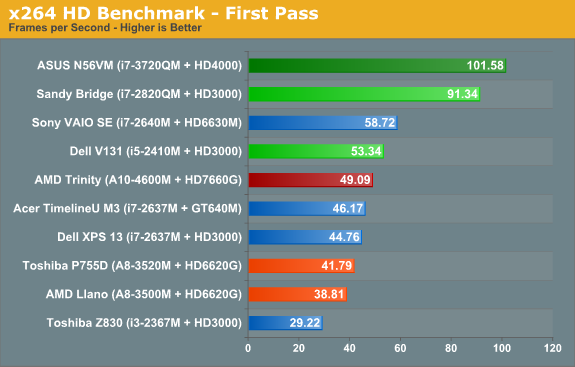
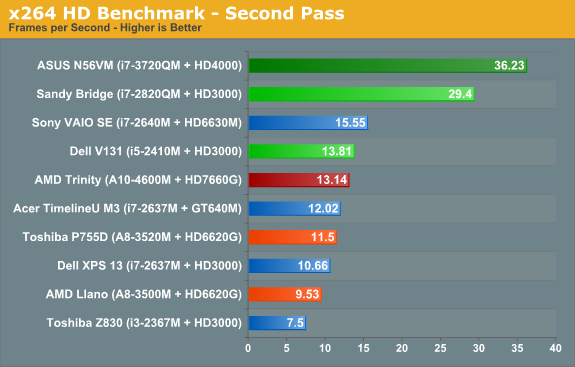
When we start drilling down into other performance metrics, AMD’s CPU performance deficiency becomes pretty obvious. The Cinebench single-threaded score is up 15% from 35W Llano, but in a bit of a surprise the multi-threaded score is basically a wash. Turn to the x264 HD encoding test however and Trinity once again shows a decent 15% improvement over Llano. Against Sandy Bridge and Ivy Bridge, though? AMD’s Trinity doesn’t stand a chance: i5-2410M is 50% faster in single-threaded Cinebench, 27% faster in multi-threaded, and 5-10% faster in x264. It’s a good thing 99.99% of laptop users never actually run applications like Cinebench for “real work”, but if you want to do video encoding a 10% increase can be very noticeable.

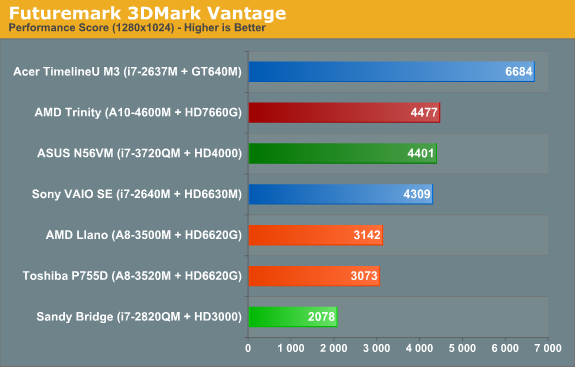
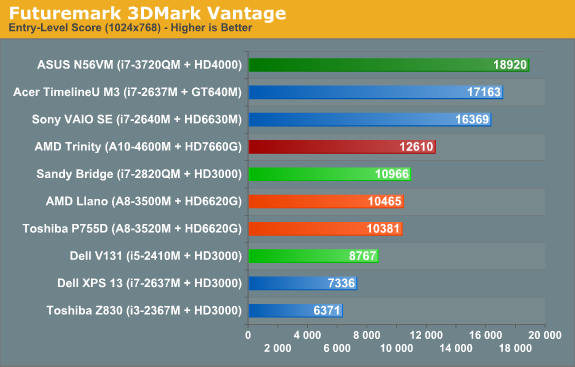
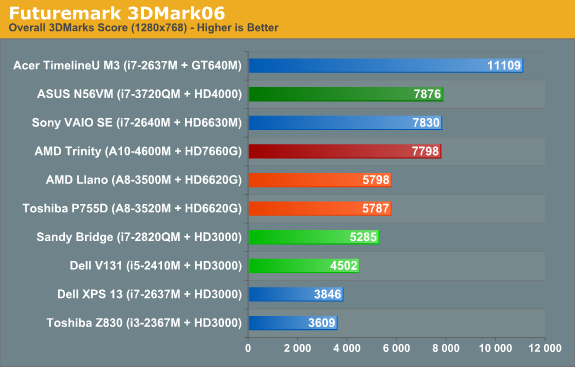
Shift over to graphics oriented benchmarks and the tables turn once again...sort of. Sandy Bridge can’t run 3DMark11, since it only has a DX10 class GPU, but in Vantage Performance and 3DMark06 Trinity is more than twice as fast as HD 3000. Of course, Ivy Bridge’s HD 4000 is the new Intel IGP Sheriff around these parts, and interestingly we see Trinity and i7-3720QM basically tied in these two synthetics. (We’ll just ignore 3DMark Vantage’s Entry benchmark, as it’s so light on graphics quality that we’ve found it doesn’t really stress most GPUs much—even low-end GPUs like HD 3000 score quite well.) We’ll dig into graphics performance more with our gaming benchmarks next.










271 Comments
View All Comments
CeriseCogburn - Thursday, May 24, 2012 - link
The average home user needs adobe reader guy. They won't get by without it - the home user always has some adobe pdf they have to be able to open. So that's the whole base.You have failed.
Spunjji - Wednesday, May 16, 2012 - link
You have quite massively misinterpreted the type of person I am. I would not have a laptop running an SB i7 if all I wanted was "good enough" and I hate management who ignore the genuine requirements of their users.The point I am making is that Trinity does *not* perform like a 6 year old CPU. It is about 2 years behind Intel, granted, but most users I have encountered are 2 years back from that in their requirements. There are edge cases and you appear to be one. Good for you. I do not wish for this to be a pissing match, I do not know 100 million business users, I have just spent a long time mediating between ordinary people and I.T. and I do it for a living.
I will be recommending Trinity to people looking for a new laptop that is good for multi-use roles, won't break the bank, and oh yes is *new*. 6 year old processors are irrelevant when you're buying a new machine, in case you hadn't noticed, and people don't just replace laptops because they want something *faster*. Your inability or unwillingness to realise this puts you at a significant distance from the majority of buyers.
CeriseCogburn - Thursday, May 24, 2012 - link
No, core 2 duos are all over the place still brand new, so maybe your customers are getting really screwed.yyrkoon - Tuesday, May 15, 2012 - link
"It's like buying a laptop from 2004, with a DX11 upgrade."Not even close. I actually own a Liano system. An A6-3400m system that in reality only operates at 1400Mhz. Despite the marketing hype that it has turbo boost to 2300Mhz. Once the CPU heats up a little, 1400Mhz is all you get. The lack of responsiveness you mention is all in your head.
Besides, when / if there were application loading slow downs, I would have to question the application its self, the storage medium which I am using, or the fact that my own system is currently only running single channel memory - First.
Even if there were some noticeable performance hit. It is not as if I had A. D. D, and could not stand to sit another 5-10 seconds.
Key word. "Priorities". We all have them. College tuition vs a laptop that will play ( next latest greatest game ) *really fast*. You have your priorities. You make the call. For your own self.
potatochobit - Tuesday, May 15, 2012 - link
you are doing it wrong.if you need more than 1500mhz you need to turn on AMD overdrive.
it is not a problem with the computer, it means your bios is probably locked by the manufacturer. you might also try googling about k10stats.
yyrkoon - Tuesday, May 15, 2012 - link
Never said anything about needing more than 1400Mhz,. I said the responsiveness "issue" was all in the original posters mind. The point I was eluding to was that the A10 should be perfectly fine with a clock speed of 2300Mhz. Even better if it can be clocked higher while remaining in a decent temperature range. Which I am thinking it should.And yeah, K10STATs works just fine, for running the clock up to 2300Mhz. *If* I did not care about the laptop CPU temps running at 89C, and above. Which I would add, is the wrong way.
@rarson
I can retype it just for you, if my point was not clear. Sorry, the A6-3400M part must have thrown you. EL EL A EN OH - Better ? Or still too confusing for you ?
Seriously? Is that the best you've got ?
Roland00Address - Tuesday, May 15, 2012 - link
but can we have a follow up with how mobile trinity and ivy bridge handle diablo 3 since many laptop purchasers will be purchasing laptops with the express purpose of playing that game.A5 - Tuesday, May 15, 2012 - link
I can't imagine it'll be too different from Starcraft 2.dwade123 - Tuesday, May 15, 2012 - link
Meh. Just grab an Intel and at least a GT 640m. That's what most people would do.kshong - Tuesday, May 15, 2012 - link
The major problem that I will have with trinity is price. If Jarred's price estimate is correct (600-700 dollars), I think I will have to buy an ivy bridge cpu + nvidia geforce gt 640 computer.I wish AMD would sell an A-10 powered laptop for 450-550 dollars. Now that is a price that I am willing to pay for. Otherwise, I think I will pay a bit more to get something else.